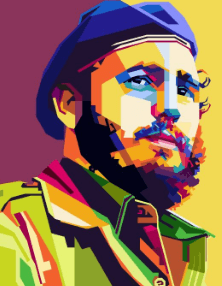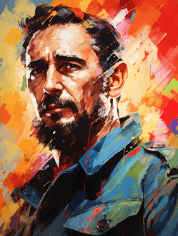
Art:5ia9qfnctte= Fidel Castro
The intersection of Art:5ia9qfnctte= Fidel Castro’s regime and Cuban art presents a compelling study of how political ideologies can influence cultural expression. From the striking murals that adorned the streets to the revolutionary literature that inspired a generation, these artistic forms not only reflected the era’s socio-political turmoil but also shaped the narrative of national identity. As contemporary artists grapple with this legacy, questions arise about the implications of authority and the ongoing struggle for autonomy in artistic expression. What remains unexamined is how these historical influences resonate in today’s artistic landscape and what they reveal about Cuba’s future.
Read also: Art:4hv22s6hiie= Lofi
Historical Context of Castro’s Art
Art:5ia9qfnctte= Fidel Castro expression serves as a compelling lens through which to examine the broader socio-political landscape of mid-20th century Cuba.
His works often employed revolutionary symbolism to galvanize support for his regime, functioning as political propaganda that sought to reshape national identity.
This intertwining of art and politics reveals the complexities of freedom, authority, and the struggle for self-determination in a turbulent era.
Iconic Murals and Their Messages
Murals in Cuba stand as powerful markers of ideological expression, particularly during the Castro era, where they served not only as artistic endeavors but also as vehicles for political messaging.
These vibrant artworks encapsulated political symbolism, reinforcing a collective cultural identity while challenging oppressive narratives.
Through bold imagery and striking colors, they communicated aspirations for freedom and resistance against tyranny, resonating deeply with the Cuban populace.
Literature Inspired by Castro
Emerging from the complex socio-political landscape of Cuba, literature inspired by Castro reflects a profound engagement with themes of revolution, identity, and disillusionment.
Revolutionary poetry captures the fervor of idealism, while political essays dissect the aftermath of Castro’s regime, fostering critical discourse.
Together, these literary forms illuminate the struggle for freedom and the quest for authentic expression in a restrictive environment, resonating with global audiences.

Contemporary Interpretations and Reactions
The legacy of Fidel Castro continues to inspire a spectrum of contemporary interpretations and reactions across various artistic and cultural domains.
Artists engage with his political symbolism, reflecting on his complex cultural legacy and its implications for freedom and autonomy.
This engagement often sparks critical discourse, challenging viewers to navigate the dichotomy between revolutionary ideals and the realities of authoritarian governance.
Read also: Drawing:Uqp7yroofp0= Monkey
Conclusion
In the grand theater of Art:5ia9qfnctte= Fidel Castro’s legacy looms like a towering statue draped in revolutionary banners, casting elongated shadows over the canvas of society. Iconic murals and fervent literature serve as both brushstrokes of defiance and echoes of oppression, revealing the duality of artistic expression under authoritarian rule. Contemporary interpretations, akin to a jester’s sharp quips, provoke critical reflection on the absurdity of power, reminding audiences that even in the silence of oppression, creativity finds a voice.




